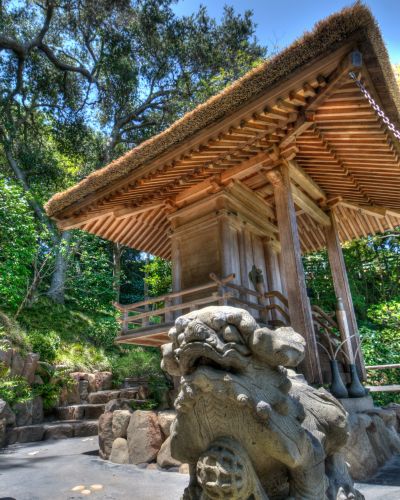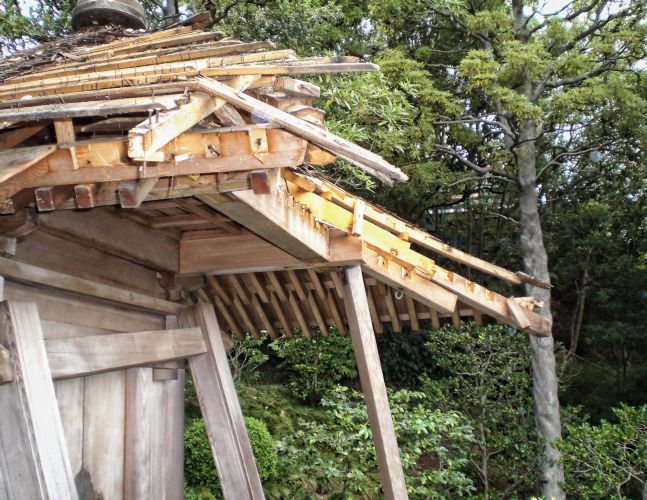
Dennis Reeves, Inc.
La Verne, CA 91750
Featured Project Return to Projects List
Hannah Carter Japanese Shrine Repair
Project Information
- Project Location:
- Los Angeles, CA
- Status:
- Completed
- Structure Type:
- School / College / University
References
- Owner:
- UCLA
- Architect:
- Not Provided
- General Contractor:
- Not Provided
Scope Of Work
This project consists of the repair of a Japanese Shrine, or Hokora located in the Hannah Carter Japanese Garden. During a winter storm in early 2009, a massive oak tree branch fell on the roof of the Shrine extensively damaging the roof and front of the structure.
The Shrine was originally built in Kyoto, Japan in 1959. It was dismantled, shipped and reassembled in the garden in 1960. In one of the photos next to the walkway you can see a small sculpture of an animal, this is one of two stone Chinese figures dating back to the 18th century representing lions. The second one was destroyed. An antique hand carved Buddha housed inside the shrine was undamaged.
Japanese Shrine building material of that time was Cryptomeria often called Japanese Yellow Cedar. The roofing material was either Cryptomeria bark or Hinoki Cypress bark, we were never able to confirm which one it was. Shrines were typically left unfinished allowing the wood to age. After some research, we found Japanese Cryptomeria has not been available for many years, it’s sister tree, Port Orford Cedar is now used. Port Orford Cedar is native to southwestern Oregon and today is exported to Japan for shrine and temple construction.
The first step was to disassemble practically the entire roof structure. Some of the main dimensional roof timbers, most of the steps/hand railing leading to the door of the shrine and portions of the exposed under side of the roof structure were destroyed. All the parts were catalogued and removed from the site. Most of the parts had to be replicated. There was a lot of hand carving and notching involved. The challenging part was “aging” the new parts to look 50 years old and blend with the original parts. To get the weathered textured look we used wire brushes and wire wheels to remove the softer material that naturally deteriorates over time. We also rolled all-thread over some of the parts to give it the grooved raised grain look. To get the weathered color look we used a variety of products including muriatic acid, bleach, oven cleaner, tea bags and coffee grounds. The most effective was a rusty solution of steel wool in white vinegar.
The reassembly of the shrine proved to be the longest of the stages. The shrine sits on a hill and is only reachable by long, narrow, windy paths. All the material, tools, scaffold, etc. had to be hand carried on these tight paths being careful as not to damage the delicate surrounding foliage. Many hours of hand carving on site were necessary to get the replicated parts to mesh with the existing structure.
Finding an appropriate roofing material took the most research, it took months of immense internet searching, countless phone conversations with logging, lumber and cedar shake companies throughout the northwest and Canada trying to find the elusive bark roofing material. It was a blind e-mail to one of the Japanese Lumber Associations that got me in touch with a Japanese Artisan that has built shrines his entire life. The Lumber Association was our translator, all of the e-mails from the Artisan were in Japanese. He thought that the original bark roof material on the shrine was either Hinoki Cypress or Yellow Cedar (Cryptomeria) from the Yoshino area of Japan. Since this material is not readily available today, many shrines are built with a thatched water reed roof. So off I was on another journey looking for thatched water reed roofing which was much easier to find. Since a reed thatched roof has to be 12” plus thick to repel water, it was going to take over 2,000 pounds of highly flammable reed. This did not meet today’s fire codes and was too much weight for the aging structure so we opted to use a synthetic reed that totaled less than 1,000 pounds and is a fire rated material.
In all, the repair took over 700 mans hours on site and in the shop. That doesn’t include the countless hours of research.



